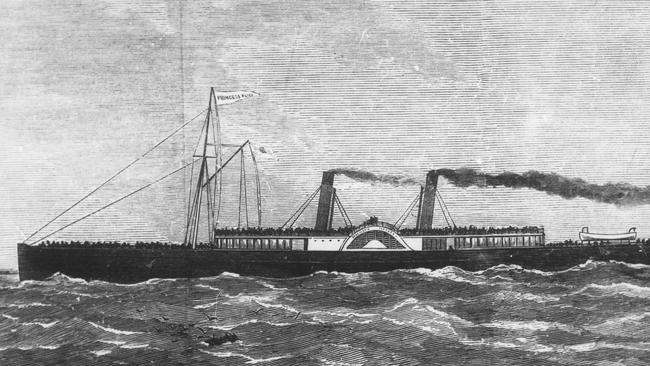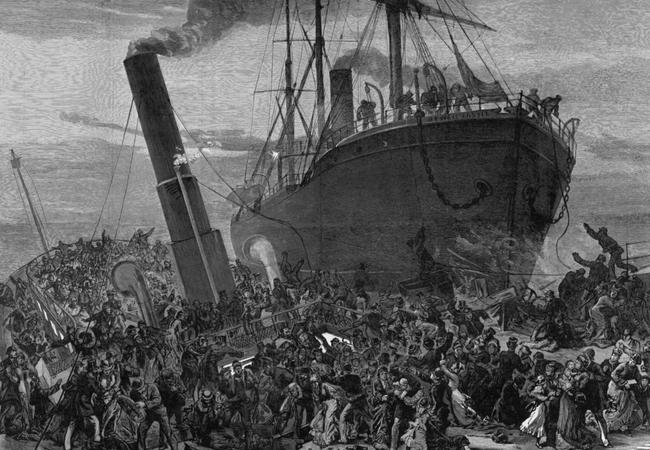Passengers on the SS Princess Alice drowned in raw sewage in the Thames
ABOUT 640 people on a Thames cruise drowned in slops of fresh sewage in Britain’s worst civilian nautical disaster.

Today in History
Don't miss out on the headlines from Today in History. Followed categories will be added to My News.
“THE band was playing at the time, they had been playing a polka, and as I pushed past there were three or four girls trying to dance to it but there was not room,” recalled Emma Eatwell, a resident of Piccadilly.
She was among just 85 day-trippers aboard the paddle-steamer SS Princess Alice to survive when disaster struck near Woolwich Pier, just before 8pm on a balmy Tuesday 140 years ago.
Split in two when hit on September 3, 1878, by a much larger coal hauler, the Newcastle-bound Bywell Castle, the SS Princess Alice took four minutes to sink into the putrid River Thames, where about 640 passengers drowned in slops of freshly released sewage.
By midnight, “all the police of the town” were helping “lay the corpses in order, putting labels on their breasts”, a reporter explained. Outside on a balcony “lie, as in repose, the bodies of three or four little children, mere babies. The majority of the dead are women.
“A body has been identified, that of Joseph Freeman, the steward, who has been with the company all his life. The engineer was saved, but the captain, William Grinstead, and all or nearly all the remainder of his crew, are among the lost in the dark river.”
Another account of Britain’s worst civilian nautical disaster described “a row of little innocents, plump and pretty, well-dressed children, all dead and cold, some with life’s ruddy tinge still in their cheeks and lips”.
The 13 year-old SS Princess Alice, at 66.8m long by 6.2m wide and operated by the London Steamboat Company, was originally licensed to carry fewer than 500 passengers. For smooth-water service on the River Thames, a Board of Trade certificate allowed her to carry up to 936 passengers.
The Princess Alice left London at about 10am on a clear day to ferry sightseers first to Gravesend, where many alighted to visit the popular Kent Zoological and Botanical Gardens Institution, better known as Rosherville pleasure gardens, designed over 6.9ha in a disused chalk pit. Other passengers continued through to sandy beaches on the Thames estuary north of Sheerness, on the Isle of Sheppey in North Kent.

The Princess Alice left Gravesend just after 6pm for the return “Moonlight Trip” of about 20km along a winding section of the Thames to Swan Pier, near London Bridge, first stopping at North Woolwich Pier. The tide was running out as the Princess Alice passed drab Thames flatlands around Beckton Gasworks at Gallions Reach, the biggest bend in the section. To defeat the tide the Princess Alice, hugged the south bank of the Thames. When within sight of Woolwich Pier, she swung north and was midstream, off Beckton Gasworks, when the Bywell Castle hit.
The Bywell Castle usually hauled coal to Africa, but at the time held no cargo as she had just been repainted at a dry dock. Skippered by Captain Thomas Harrison, he was guided by an experienced Thames river pilot.
Harrison had ordered her engines reversed, but too late to avoid a collision. The Bywell Castle struck the Princess Alice on the starboard side, splintering the paddle-box.
“The knife-edge bow of the Bywell Castle had driven right through to the engine-room,” observers noted. “For all that mattered, the Princess Alice was sliced in two. Water gushed in, filling every void in its path. The forward part of the vessel sank like a bag of nails.”
Passengers were either trapped in the sinking craft, or thrown into the river at Tripcock Point, 1.5km downriver from Woolwich, where an hour earlier sluices opened to release 27 tonnes of raw sewage.
Another steamer, the Duke of Teck, rushed to rescue Princess Alice passengers, but found “the river for a 100 yards was full of drowning people, screaming in anguish”.
Of the victims, many were women weighed down by heavy clothing, and 240 children “whose light bodies and ample drapery had kept them afloat even while they were smothered.
“One young woman says that her baby was washed out of her arms, and that she has lost her husband and three little ones,” newspapers reported.
Emma, rescued after being in the water for 30 minutes, says she “suffered very much from the state of the water and my chest is now very bad. The water was very dreadful and nasty, it was in a very foul state indeed.”
Public opinion blamed Harrison for the disaster but a later Board of Trade inquiry concluded Captain Grinstead of the Princess Alice, a victim of the tragedy, was at fault because he had changed course, moving across the path of the Bywell Castle.
